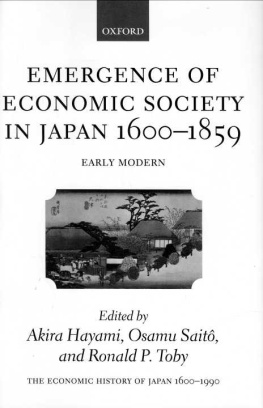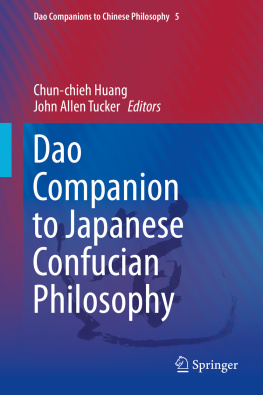The Economic History of Japan: 1600-1990
VOLUME 1
The Economic History of
Japan: 1600-1990
VOLUME 1: Emergence of Economic Society
in Japan, 1600-1859
Edited by
AKIRA HAYAMI
OSAMU SAITO
RONALD P. TOBY





PREFACE
In the expectation that this work will be most useful to readers who do not have access to scholarship in Japanese, we decided to make the work more than simply a translation of the Japanese version-an introduction has been added, and several changes and additions have been made for readers unfamiliar with the history of Japan, including the Appendix for those who are not familiar with early modern Japanese history.
We have also included a glossary: with these additions, we hope to provide readily understandable explanations for the administrative and monetary systems, as well as the systems of weights and measures, the calendar, and other features characteristic of early modern Japan, as an aid to readers not yet familiar with the history of Tokugawa Japan. The references are also listed in a standard Western format, rather than using the format of the original Japanese.
Economic history as a field in Japanese scholarship has a history of nearly one hundred years. As with other social sciences, economic history in Japan began with the introduction of methods used in the West. Initially, early in the last century, research focused heavily on institutional history, and German economics of the historical school, but the interwar era (1920s and 1930s) witnessed a factional split in economic history between a methodology based on one specific ideology, Marxism, on the one hand, and a variety of other factions that were primarily descriptive, but lacked any clear methodology. This ideological and methodological division strengthened in the postwar era, a trend that continued until the 1970s.
The 1970s, however, saw the rapid introduction of various new methodologies, reflecting the intellectual ferment characteristic of the advanced industrial nations in the 1960s and 1970s, including "New Economic History" and "Business History" that were increasingly fashionable in American academic circles, and "Historical Demography" developed in Europe, and most often identified with the French "Annales School." These various approaches differed markedly from the traditional
This research group is called the "Quantitative Economic History (QEH) Research Group," but its goals and methods are not necessarily the same as the movement in the United States that has come to be called "cliometrics." The objective of this group is to make correct and accurate use of statistical data, including the evaluation of historical source materials, and the society is not based solely on the framework of the neoclassical school of economics. However, members of the group do include specialists in development economics, so we do see more influence of modem economic analyses, methodologies, and concepts here than in traditional research in economic history. Another characteristic of this group is that it also considers areas such as consumption, demand, distribution, transportation, and population, while conventional economic history research in Japan almost entirely focused on production and supply.
In 1984, Iwanami Shoten approached us about the possibility of publishing a book on Economic History of Japan (Nihon keizai-shi). Numerous preparatory meetings were held the following year, 1985, during which we examined the fundamental objectives, details, narrative methods, number of volumes, and the authors. By the end of that year, we had hammered out the drafts for all seven volumes. However, further investigation indicated that the drafts for the "Age of Industrialization," which covered the initial era of modern industrialization, were simply too much for one volume, so the articles were reorganized into two parts, or a total of eight volumes in the work.
The authors in each of the volumes were drawn primarily from the membership of QEH, but as they could not possibly cover all aspects of Japanese economic history, approximately half of the chapters were assigned to other authors. In all cases, the authors were asked to present their volume editors with a preliminary outline of the proposed coverage of their chapters, and proceed with the writing only after the editors had examined the proposals. Volume 1 was published in November 1988 and the final volume (Volume 5) in February 1990. Publication was achieved relatively quickly for this series, the result of the dedication of the authors, editors, and publishers.
A Chinese version of the Economic History of Japan appeared in 1997, including translations of the entire series of eight volumes. This achievement was extremely surprising and gratifying to the authors, who were very eager to hear the response of economic history researchers in China to their work. With this English publication of Economic History of Japan, the work will now be available to people throughout the world, the greatest honor that we could hope for.
In this work, the Japanese names of contemporary persons are listed in the Western order, with the given name first, followed by the surname. However, for historical persons, who appeared before the Meiji Restoration (1868), the surname comes first followed by the given name.
This English version is not the same as the Japanese edition. Since we had to condense eight volumes into four, some chapters have been left out. Chapter 3 in this volume, written by Kazui Tashiro, is the translation of an article that appeared in the other book. Also Chapter 10, by Ronald P. Toby, was not included in the original Japanese edition. Not only did he contribute the chapter, but also read through all the chapters and gave us a lot of suggestions and comments. I am greatly indebted to him and to Osamu Saito, who helped to edit this volume.
The English translation of this work was made possible largely through the efforts of Professor Alan Christy, University of California, Santa Cruz, with financial help from the Daido Foundation. The editors and authors would like to express their deep appreciation to Professor Christy and the individual translators who worked with him on this project, and to the Daido Foundation. We would also like to express our appreciation to Kiko International Co., Ltd., Kyoto, particularly Ms Kiko Matsuura there for putting the draft into shape, for making arrangements for the spelling and style, and for giving me many suggestions, too.
I would like to express to Mr Stuart Fowkes, at Oxford University Press, my deepest gratitude for having him as an editor. Without his very patient cooperation, this hook would not have appeared.
Finally, I am very grateful to Ms Miyuki Takahashi Ph.D. and Ms Masako Unosawa, who worked hard on all the chapters, including checking the contents and digitalizing numerous tables and figures. Indexing was done also by Ms Takahashi. Their impressive computer literacy was displayed fully in achieving this. We are also grateful to Mr Kanetaro Saito Ph.D. who prepared the complex reference.
We are sorry to have to write here that Professor Hiroshi Shimbo, one of the most active and key people involved with this series, sadly passed away before the publication.








